
This narrated screencast explains the role enzymes play in cellular metabolism. [4:42]
- Subject:
- Science
- Material Type:
- Audio/Video
- Provider:
- Sophia Learning
- Date Added:
- 12/01/2023

This narrated screencast explains the role enzymes play in cellular metabolism. [4:42]
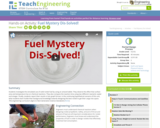
In this activity, students investigate the simulated use of solid rocket fuel by using an antacid tablet. Students observe the effect that surface area and temperature has on chemical reactions. Also, students compare the reaction time using two different reactants: water and vinegar. Finally, students report their results using a bar graph.
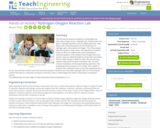
This lab exercise exposes students to a potentially new alternative energy source hydrogen gas. Student teams are given a hydrogen generator and an oxygen generator. They balance the chemical equation for the combustion of hydrogen gas in the presence of oxygen. Then they analyze what the equation really means. Two hypotheses are given, based on what one might predict upon analyzing the chemical equation. Once students have thought about the process, they are walked through the experiment and shown how to collect the gas in different ratios. By trial and error, students determine the ideal combustion ratio. For both volume of explosion and kick generated by explosion, they qualitatively record results on a 0-4 scale. Then, students evaluate their collected results to see if the hypotheses were correct and how their results match the theoretical equation. Students learn that while hydrogen will most commonly be used for fuel cells (no combustion situation), it has been used in rocket engines (for which a tremendous combustion occurs).

A video tutorial explaining the enthalpy of a reaction using an energy diagram. [2:42]
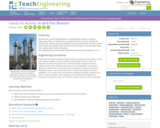
Students learn about material balances, a fundamental concept of chemical engineering. They use stoichiometry to predict the mass of carbon dioxide that escapes after reacting measured quantities of sodium bicarbonate with dilute acetic acid. Students then produce the reactions of the chemicals in a small reactor made from a plastic water bottle and balloon.

While building and testing model rockets fueled by antacid tablets, students are introduced to the basic physics concepts on how rockets work. Students revise and improve their initial designs. Note: This activity is similar to the elementary-level film canister rockets activity, but adapted for middle school students.

Listen and learn about different types of chemical reactions such as combination, combustion and decomposition. Learn different steps on how to write combustion equations and view how single displacement reaction occurs.

In this activity you can find out how to make your own Alka-Seltzer lava lamp. How will changing the temperature of the ingredients change the behavior of the colorful blobs in your laval lamp?

Chemistry is often defined as the science of matter and how it changes. This pathway introduces the composition of matter and the physical and chemical changes it can undergo.

Watch a reaction proceed over time. How does total energy affect a reaction rate? This model represents an analogy of chemical reactions.

Students learn about the basic principles of electromicrobiology—the study of microorganisms’ electrical properties—and the potential that these microorganisms may have as a next-generation source of sustainable energy. They are introduced to one such promising source: microbial fuel cells (MFCs). Using the metabolisms of microbes to generate electrical current, MFCs can harvest bioelectricity, or energy, from the processes of photosynthesis and cellular respiration. Students learn about the basics of MFCs and how they function as well as the chemical processes of photosynthesis and cellular respiration
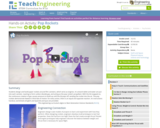
Students design and build paper rockets around film canisters, which serve as engines. An antacid tablet and water are put into each canister, reacting to form carbon dioxide gas, and acting as the pop rocket's propellant. With the lid snapped on, the continuous creation of gas causes pressure to build up until the lid pops off, sending the rocket into the air. The pop rockets demonstrate Newton's third law of motion: for every action, there is an equal and opposite reaction.

An interactive video lesson where students first determine misconceptions about what happens during chemical reactions, and then investigate some various chemical reactions.
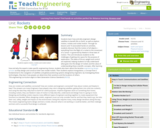
Students learn how and why engineers design satellites to benefit life on Earth, as well as explore motion, rockets and rocket motion. Through six lessons and 10 associated hands-on activities, students discover that the motion of all objects everything from the flight of a rocket to the movement of a canoe is governed by Newton's three laws of motion. This unit introduces students to the challenges of getting into space for the purpose of exploration. The ideas of thrust, weight and control are explored, helping students to fully understand what goes into the design of rockets and the value of understanding these scientific concepts. After learning how and why the experts make specific engineering choices, students also learn about the iterative engineering design process as they design and construct their own model rockets. Then students explore triangulation, a concept that is fundamental to the navigation of satellites and global positioning systems designed by engineers; by investigating these technologies, they learn how people can determine their positions and the locations of others.

Science activity shows what happens when a bag can't hold any more carbon dioxide.

Science activity shows what happens when an orange or clementine is mixed with baking soda. Links to video of the experiment.
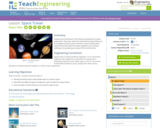
In this lesson, students are introduced to the historical motivation for space exploration. They learn about the International Space Station as an example of recent space travel innovation and are introduced to new and futuristic ideas that space engineers are currently working on to propel space research far into the future!
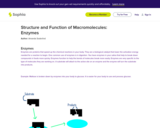
Listen to this podcast introducing the function of enzymes in the human body. [0:38]

When molecules collide, chemical reactions can occur -- causing major structural changes akin to getting a new arm on your face! George Zaidan and Charles Morton playfully imagine chemical systems as busy city streets, and the colliding molecules within them as your average, limb-swapping joes. [3:25]